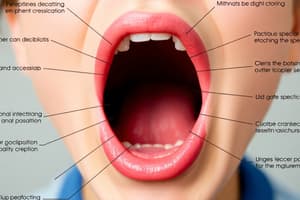Podcast
Questions and Answers
What is a common difficulty in dysarthria related to articulation?
What is a common difficulty in dysarthria related to articulation?
Which type of dysarthria results from upper motor neuron system disorders?
Which type of dysarthria results from upper motor neuron system disorders?
What type of voice quality is typically associated with spastic dysarthria?
What type of voice quality is typically associated with spastic dysarthria?
Which condition can lead to ataxic dysarthria?
Which condition can lead to ataxic dysarthria?
Signup and view all the answers
What is a common phonation characteristic of individuals with ataxic dysarthria?
What is a common phonation characteristic of individuals with ataxic dysarthria?
Signup and view all the answers
Which type of dysarthria results from cerebellar lesions?
Which type of dysarthria results from cerebellar lesions?
Signup and view all the answers
What is the primary characteristic of dysarthria?
What is the primary characteristic of dysarthria?
Signup and view all the answers
What is the main difference between dysarthria and cerebral palsy in terms of speech disorders?
What is the main difference between dysarthria and cerebral palsy in terms of speech disorders?
Signup and view all the answers
What is the primary cause of speech errors in dysarthria?
What is the primary cause of speech errors in dysarthria?
Signup and view all the answers
Which of the following is not a characteristic of cerebral palsy?
Which of the following is not a characteristic of cerebral palsy?
Signup and view all the answers
What type of speech errors are characteristic of dysarthria?
What type of speech errors are characteristic of dysarthria?
Signup and view all the answers
Which of the following is not a component of the speech process affected in dysarthria?
Which of the following is not a component of the speech process affected in dysarthria?
Signup and view all the answers
What is the primary characteristic of a speech sound disorder?
What is the primary characteristic of a speech sound disorder?
Signup and view all the answers
Which type of speech sound disorder is associated with Down Syndrome?
Which type of speech sound disorder is associated with Down Syndrome?
Signup and view all the answers
What is the primary difference between an articulation disorder and a phonological disorder?
What is the primary difference between an articulation disorder and a phonological disorder?
Signup and view all the answers
What is the primary characteristic of an organic speech sound disorder?
What is the primary characteristic of an organic speech sound disorder?
Signup and view all the answers
What is the primary characteristic of a motor/neurological speech sound disorder?
What is the primary characteristic of a motor/neurological speech sound disorder?
Signup and view all the answers
What is the primary characteristic of a sensory/perceptual speech sound disorder?
What is the primary characteristic of a sensory/perceptual speech sound disorder?
Signup and view all the answers




